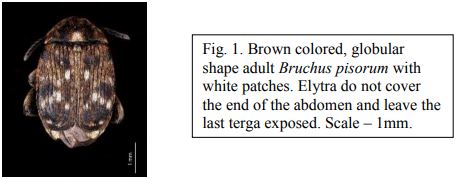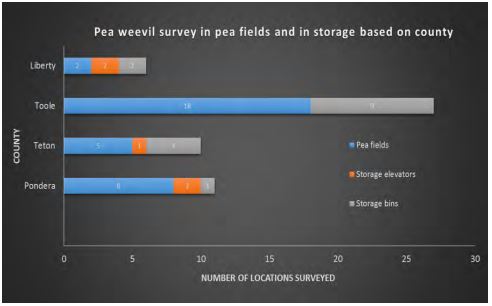New pest in Montana-Pea weevil: Determining weevil population distribution, abundance, and pea damage assessments
Principal Investigator: Gadi V.P. Reddy
Project Personnel: Ramadevi L. Gadi, Debra Miller, Anamika Sharma, and Dan Picard Montana State University, Western Triangle Ag Research Center, Conrad, MT
Aim of the Study
The aim of this study was to survey for determining the pea weevil, Bruchus pisorum (Coleoptera: Chrysomelidae) population distribution, abundance and pea damage assessment for Montana. The pea weevil is one of the most problematic insect pests on field peas (Fig-1). The larvae feeding inside the developing pea seed cause damage. Weevil infestations ranges between 30–70% in untreated crops. Affected peas are unfit for human consumption and their seed germination rate decreases, which in turn diminishes the market value. In Montana, damage by this weevil was reported for the first time in the Hi-Line area in 2014, which alarmed pea growers and stakeholders because this pest could easily spread to neighboring pea-growing areas. Consequently, with the funding from USA Dry Pea and Lentil Council, the pea weevil surveys were carried out during 2016 and 2017 in 33 field sites, five elevators and 16 farm bins in the Golden Triangle Area including Hi-Line area. The primary objective was to determine the damage potential and distribution of the pea weevil.
Fig. 1. Brown colored, globular shape adult Bruchus pisorum with white patches. Elytra do not cover the end of the abdomen and leave the last terga exposed. Scale – 1mm.
Methods
Survey of pea weevil
Thirty three pea fields, five elevators and 16 farm bins in Pondera, Teton, Toole and Liberty counties were selected in Hi-Line and North Central areas of Montana for the survey of pea weevil (Figure-2). A sample of 2,000 seeds from the plots and elevators are collecting every two weeks from May 2017 to May 2018. Also, 150 sweep nets in each field are carried out before to the blooming stage during spring. The samples are transported to the laboratory at WTARC and analyzed for damage and different life stages of the pea weevil.
Figure 2. Surveyed areas for pea weevil (Bruchus pisorum) in Golden Triangle Area of Montana in 2016–2017.
Assessment of damage distribution and abundance
The number of peas with exit holes and immature stages (egg, larvae, pupae and adult) will be counted from the samples from different locations in the laboratory. Damage levels are assessed based on the scoring system. 0=no damage; 1= slight damage (less than 5%); 2= moderate damage (5-20%); 3= heavy damage (more than 20%).
Relationship between damage and weevil numbers
The intention was to identify a relationship (correlation) between damage levels and weevil numbers. Pearson’s correlation analysis - determine, whether or not, there is a significant correlation between damage levels and weevil number for both sampling periods, and in all damage categories. Data were include damage levels on different pea varieties, grown at different locations.
Mass rearing of pea weevil in the laboratory
The immature stages of the pea weevil will be collected from the field and grain bins. Mass reared in the laboratory to help in conducting further studies.
Results
No incidence of weevil presence was noticed in the surveys of 2016–2017. However, recently the damaged seeds with live pea weevils were confirmed from the Chester area (December, 2017) by the State Grain Lab. This incidence indicates the necessity of continuing the survey work.
Conclusions
Pea weevil damage was noticed in Montana during December 18, 2017. In an event of significant levels of crop damage and noticeable population levels, efforts will be undertaken to obtain a USDA-APHIS permit to introduce the pea weevil egg parasitoid Uscana senex (Hymenoptera:Trichogrammatidae) into Montana. This parasitoid, is reported to show up to 82% of parasitism rate. Detailed information on the biology, ecology and management of pea weevil was reviewed and published by our team.
Acknowledgements
This work was supported by USA Dry Pea & Lentil Council and American Pulse Association. We would like to thank summer intern Carley Taft for assistance with field work.
Papers published
Reddy, G.V.P., A. Sharma, and R.L. Gadi. 2017. Biology, ecology and management of the pea weevil, Bruchus pisorum (Coleoptera: Chrysomelidae). Annals of the Entomological Society of America 110: 10.1093/aesa/sax078.
Gahukar, R.T., and G.V.P. Reddy. 2017. Management of insect pests in the production and storage of minor pulses. Annals of the Entomological Society of America 111: doi:10.1093/aesa/sax077.


